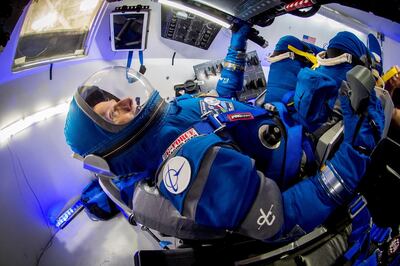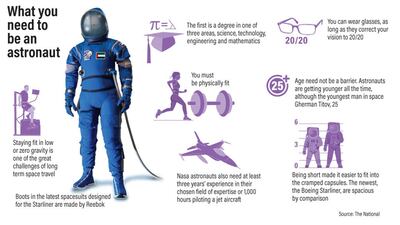If you’ve survived the Formula Rosso at Yas Island’s Ferrari World, then it might be time to consider a new career as the UAE’s first astronaut.
With a top speed of 240kph, the world’s fastest roller coaster produces a g-force of about 4.8 - higher than a rocket blasting into space.
As the UAE prepares to begin the search for up to six pioneering astronauts who will carry the country’s space ambitions to new heights, being able to withstand the forces subjected to the human body on lift off and re-entry is just one of the qualifications.
According to Salem Humaid Al Marri, assistant director general at the Mohammed Bin Rashid Space Centre, the search for the UAE’s first astronauts could begin as early as the end of this year.
Read more: UAE ready to train its first astronauts from as early as next year.
Once the selection has been made, the successful candidates will then go years of training, with the aim sending the first man – or woman – into space by 2021, the UAE’s 50th birthday. While has not been specified, it is likely that UAE nationals will be given priority.
But what are the other requirements needed to be an astronaut – what the writer Tom Wolfe called “the Right Stuff” when referring to the first Americans to go in space nearly 60 years ago.
“The most important characteristic for an astronaut is perseverance,” said Dr Deborah Barnhart, the CEO of Space Camp, an education programme at the US Space & Rocket Centre in Alabama.
Dr Barnhart, who will be visiting the UAE next week as part of Discover America month, said she has known would-be astronauts who were turned down up to five times before finally being accepted by Nasa.
Space Camp is an educational venture designed to promote interest in science and space among young people, include several who went on to become astronauts.
“First of all you will need dedication to high achievement in whatever you do,” she said.
The ability to work in a team is also vital.
“You should also be a well rounded individual, capable of doing as many things as you can," she said.
Nasa divides the basic requirements for new astronauts into three areas.

The first is a degree in one of three areas, science, technology, engineering and mathematics. This is important because today’s astronauts need to be able to carry out research and experiments, especially on the International Space Station.
Nasa astronauts also need at least three years' experience in their chosen field of expertise, or 1,000 hours piloting a jet aircraft.
Finally, they must be physically fit.
The fitness requirement is not as tough as it once was. You can wear glasses, as long as they correct your vision to 20/20. Almost anyone with normal weight and fitness can safely go into low Earth orbit with the right training, which typically take a minimum of two years before a mission.
The first astronauts were also noticeably short. Yuri Gagarin, the first man in space, John Glenn, the first American to orbit the Earth, and Neil Armstrong, the first man on the Moon, were all under 5ft 9ins. Gagarin, who piloted Vostok 1 in 1961, was only 5ft 1ins.
Being short made it easier to fit into the cramped capsules of the first rockets. The newest ships, like the Boeing Starliner, are spacious by comparison, seating up to seven, including passengers. And while it still helps to be shorter, Jim Wetherbee, who holds the record for Space Shuttle missions at five, is 1.93 metres, or 6ft 4ins.
Age need not be a barrier. Astronauts are getting younger all the time, although the youngest person in space was also the second man in space; Gherman Titov was just 25 when he flew Vosktok 2, just four months after Gagarin.
Watch: Gherman Titov becomes the youngest person in space.
Of the latest intake of 30 Nasa astronauts, a third are aged 30 or younger. Nor is old age necessarily a barrier. John Glenn was 77 years old when he returned to space in 1998 on the shuttle Discovery.
It will also help if you have a good exercise regime. Staying fit in low or zero gravity is one of the great challenges of long term space travel, where the danger is muscle and bone density loss. Both Nasa and the European Space Agency have developed exercise routines for astronaut training.
Once in orbit, astronauts on the International Space Station have access to specially designed exercise machines including weights and treadmills. Typically, Nasa astronauts will spend two and half hours a day exercising while in orbit. Some astronauts have even completed marathons while orbiting the Earth.
It's not for nothing that the boots in the latest spacesuits designed for the Starliner are made by Reebok.


